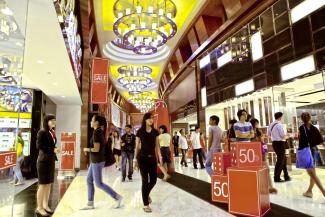
The Institute of Service Excellence (ISE) at the Singapore Management University (SMU) (卓越服务研究院) released the 2022 Customer Satisfaction Index of Singapore (CSISG) survey results for the Info-Communications and Retail sectors today.
The annual study showed Retail sector customers’ latest satisfaction score come in at 71.3 points (on a 0 to 100 scale), a statistically significant decline of 1.5% compared to last year. On the other hand, the Info-communications sector saw its satisfaction score notch up 1.9% year-on-year to reach 69.8 points, reversing two years of decline.
Retail Sector Insights
The Retail sector’s CSISG performance was derived from four constituent sub-sectors. Its poorer year-on-year showing was primarily due to the Department Stores sub-sector (70.9 points), dipping 2.4%, and the Fashion Apparels sub-sector (72.1 points), dipping 1.7%. The other two sub-sectors, Supermarkets (71.4 points) and e-Commerce (70.8 points), saw smaller declines of 0.8% and 0.5%, respectively.
Customers of Department Stores and Fashion Apparel stores also registered significantly lower levels of customer loyalty, with scores falling by 4.0% and 3.5% respectively. Loyalty in the CSISG study is defined as the likelihood of repurchasing from the store or brand, and tolerance to changes in price.
Further analysis of customer responses for these stores and brands suggests that product-related attributes, such as product variety and quality, and in-store experiences, such as promotions, pricing, and store design, were key drivers to improving loyalty.
“Another big way for the shops to improve customers’ experience is to build a seamless omni-channel option into the shopping journey,” said Ms Neeta Lachmandas (妮塔.拉切曼达斯), ISE Executive Director (执行总监).
Indeed, these latest results showed large differences in customer satisfaction and loyalty levels between customers who only did their shopping through a physical store, and those who had an omni-channel experience, i.e., shopped online and in-store. For instance, Fashion Apparels sub-sector respondents indicating only physical store shopping experiences had a customer loyalty score of 70.2 points. In contrast, customers with an omni-channel experience had a loyalty score of 76.6 points, a remarkable 9.1% higher.
Another interesting observation for the Retail sector was the prevalence of cashless payments and its impact on customer experience. The CSISG study, which has been tracking consumers’ payment behaviour over time, saw cashless payments usage surge, from 44.8% in 2018 to 82.9% in 2022. Cashless payment in the CSISG study is defined as consumers’ most frequent form of payment when making a purchase, whether it was via physical credit and debits cards, NETS, or mobile wallets such as Apple Pay and GrabPay.
“While the growth in cashless payments has already been on a healthy upward trajectory for years prior, Covid-19 seemed to have accelerated adoption. This shift in payment behaviour also brought about seemingly better shopping experiences, such as greater satisfaction with retail payment processes,” observed Ms Lachmandas.
As comparison, retail customers who used cashless payments gave a satisfaction rating of 7.51 points (on a 1 to 10 scale) for Payment Process, significantly better than customers using cash, with an average rating of 7.17 points.
Info-Communications Sector Insights
This latest CSISG survey also looked at how the Info-communications sector improved from last year: The upswing came from the Mobile Telecom (70.0 points) and Broadband (68.3 points) sub-sectors, which registered a 1.2% and 2.2% increase in their satisfaction scores, respectively. The other two sub-sectors that make up the Info-communications sector were the Video Streaming Services sub-sector (72.7 points), clocking a 0.9% year-on-year dip in score, and the Pay TV sub-sector (69.6 points), whose score was not comparable to previous years due to a change in data collection methodology, moving from face-to-face interviews to online surveys.
Within the Mobile Telecom sub-sector, the year-on-year increase in the satisfaction score was driven by significant improvements by the Mobile Virtual Network Operators (MVNOs), such as Circles.Life, GOMO, and MyRepublic. These operators saw marked improvement in key drivers of customer satisfaction, such as product and service quality, and perceived value.
In particular, MVNOs outperformed the legacy telcos in perceptions of value: MVNOs registered a Perceived Value score of 78.7 points while the legacy telcos scored 75.2 points. MVNO customers were also more likely to stay with their current operator and were more tolerant to subscription fee increases, compared to customers of the legacy telcos.
“The MVNOs improvements in the latest survey resulted in performance attributes that were very much on par with the legacy telcos, while offering a substantially different service proposition. However, the key drivers to maintain customer loyalty remain similar, and that’s to focus on responsiveness and empathy-related attributes,” remarked Ms Lachmandas.
In addition to responsiveness and empathy attributes, such as “Providing prompt service” and “Makes the effort to understand the customer”, impact analysis also suggests product attributes, such as “Data network reliability” as a key driver of loyalty for MVNOs.
The CSISG 2022 Q1 study was conducted between January and April 2022. A total of 4,800 consumers were surveyed, covering 99 distinct business entities from the Info-communications and Retail sectors. The Index has 40 entities with published scores.
Please refer to Annex A for a background on the CSISG and Annex B for the detailed scores.